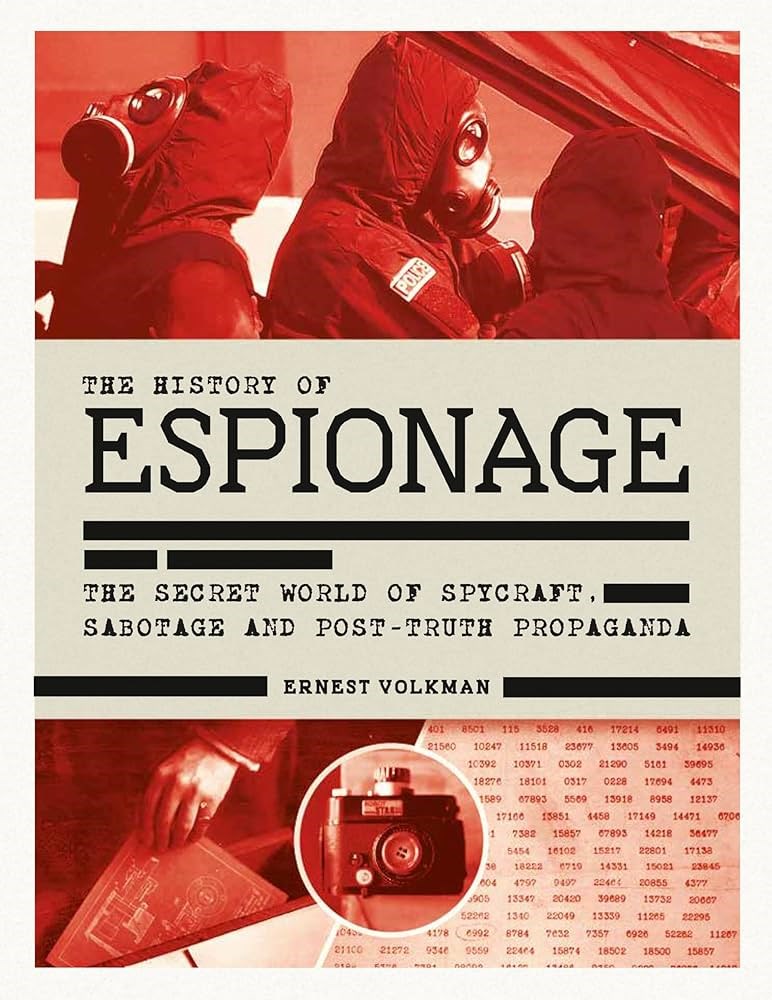The History of Espionage The Secret World of Spycraft, Sabotage and Port-Truth Propaganda
Ernest Volkman
Carlton Books, 208 pages
This is a book for lovers of spy stories, although readers looking for the character development, interpersonal intrigues and romantic entanglements found in novels or short stories by John le Carré, Graham Greene or W. Somerset Maugham will be disappointed – there is none of the suspense found in the storylines of the above authors, but on the other hand there is plenty of original ideas, skullduggery and quite a few surprises (for me, at least) along the way.
Volkman opens with an anecdote about a question asked of the Duke of Wellington: what does he think of on the night before a battle?
“What’s on the other side of the hill?” was his reply. A quite reasonable answer, I think, after all, that is the raison d'etre of espionage, be it military, diplomatic or industrial in nature or, as Volkman explains, strategic, tactical or counterintelligence. It is an old profession: a 1500-year-old clay tablet contains, in cipher form, the formula for making porcelain. Another ancient example dates from 490 BCE when intelligence gathered by Athenians enabled them to defeat an attack by the Persian king Xerxes.
The Israeli occupiers of Masada in 73 CE were convinced that their fortress was invincible and therefore did not bother to gather intelligence about their Roman enemies. The Roman general Silvius, on the other hand, had his spies collect every possible scrap of information, and as a result planned a very successful attack which conquered Masada.
Even if the Israelis had had intelligence at their disposal they would probably not have been able to resist the Romans, but Silvio’s knowledge of what was, in this case, on top of the hill and not on the other side, made him the victor.
Volkman describes many interesting examples of spycraft involving military campaigns, diplomacy and scientific and industrial secrets. In the process he unmasks a number of well-known historical personages as spies, inter alia W. Somerset Maugham himself, Marco Polo, King Louis XV, Harriet Tubman and Robert Baden-Powell, founder of the Boy Scouts. That this aspect of their lives are not well known today may be due to the fact that a major requirement of spycraft is that its practitioners should remain anonymous at best or at least not suspected of such clandestine activities.
Once a spy has gathered intelligence it must in some way be transmitted to his/her superiors, and various innovative methods have been devised for this purpose. The one I like most is by Baden-Powell, who used sketches of insects or landscapes to hide his information. After all, butterfly hunters are regarded as harmless and eccentric, so who would suspect his drawings to contain military information – see the link at the end.
Famous generals tend to have rather large egos, often thinking that they know better than their staff who have been trained to evaluate the relevant information, muddy as it often is in war. Napoleon is no exception – he lost major battles and probably his empire because he so stubbornly believed that he knew best.
Much of modern spycraft was developed by Frau Doktor Elsbeth Schragmueller, who intensively trained German spies in World War One. Her methods were so successful that they were adopted by many nations after her death.
Two of the three largest and most successful spy agencies were the Russian KGB and the HVA, East Germany’s foreign intelligence service, headed by Markus Wolf, without doubt the most successful spymaster in modern history. He was thought to be the model for Karla in Jon le Carré’s books, and his autobiography, Man Without a Face is fascinating reading and is still available.
Pearl Harbour, the atom bomb, the British spy scandal and many other events are described in this book’s wide sweep, and it ends with a coda devoted to cyberspies, which is most likely to remain the spycraft for the foreseeable future.
Both readers who managed to stay awake may have noticed that I wrote “two of the three largest and most successful spy agencies,” namely the KGB and the HVA. The third is certainly Israel’s Mossad, which seems to have completely missed Hamas’ planned attack on October 7th. On the other hand, some sources say that Mossad knew, others deny it and who am I to agree or disagree.
The views and opinions expressed in this article are those of the author, and do not necessarily reflect the position of this publication.




